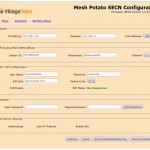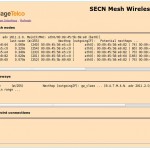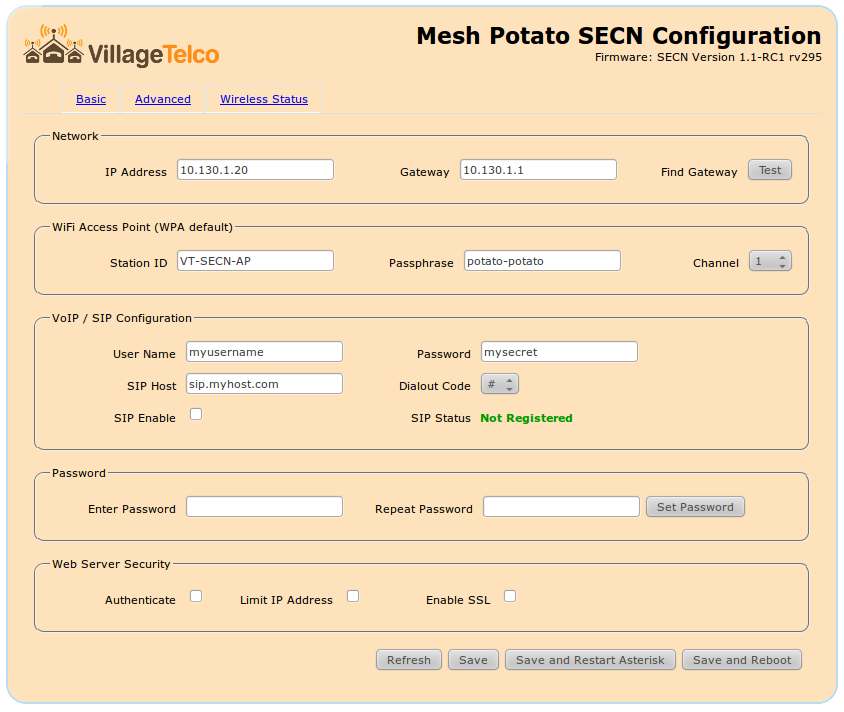Thanks to the amazing work of Terry Gillett, Keith Williamson, and Elektra, I am happy to announce version 1.1 (RC2) of the SECN firmware. SECN is the firmware developed by Terry Gillett which features the use of batman-adv instead of batman mesh protocol as well as easy configuration of a WiFi hotspot for the Mesh Potato. From an interesting alternative, the SECN firmware has gone on to become the default firmware for the Mesh Potato. Here is a list of features that you can find in the 1.1 firmware. So what’s new in the 1.1 version?
 A Simple Configuration User Interface (UI)
A Simple Configuration User Interface (UI)
While LuCI is tremendously powerful, we have found that it can be intimidating for new users. It also doesn’t offer the VoIP configuration features that are key to Village Telco. The new configuration UI in version 1.1 offers the most important basic options including: setting the IP address and gateway, the WiFi hotspot, and configuring your VoIP provider details. The UI is smart enough to stop you putting in a malformed IP address or from choosing a WPA key for your hotspot that is too short, etc. It can also try to guess your gateway for you. Of course you don’t HAVE to use the web interface to configure your Mesh Potato. You can also configure it by phone.
Easy VoIP Setup
Previously you were obliged to edit the Asterisk configuration files in order to set up a SIP account with your VoIP Service Provider. Now all you need is the URL of the the SIP provider and your username and password. The UI also indicates when the Mesh Potato is successfully registered to the SIP provider. This is set to work with the most common default setting of VoIP services providers. You can go to the Advanced setting page if you require custom VoIP options.
Simple Access Point Configuration
Setting up the Mesh Potato as a WiFi access point is a breeze. Simply enter your preferred name for the WiFi network (the SSID) and then choose the form of encryption you prefer for the network. By keeping the SSID the same for all of the Mesh Potatoes on your network, you can create a large, seamless hotspot. Most WiFi-enabled devices will hand-off from access point to access point if you move around in the network allowing you limited mobility within the network.
Security Options for your Mesh Potato
Once you’ve configured your Mesh Potato, you may not wish to make it so easy to access the configuration options for your Mesh Potato. You have to consider the fact that your Mesh Potato can be reached by anyone on the mesh network. The new firmware offers three options for securing your Mesh Potato.
- Encryption. You can turn on the encrypted web interface which will secure all traffic to the Mesh Potato making it extremely difficult for anyone to intercept configuration traffic to the Mesh Potato. This means that you would access the same web UI but using the HTTPS protocol.
- Password. You can require a username and password to access the UI. This is based on the root or admin user accounts on the Mesh Potato.
- Limit IP addresses. You can also make the webserver accessible only through the fallback IP address.
You can also disable the web interface entirely via the phone interface.
Integrate Smartphones with your Village Telco
The Mesh Potato is entirely standards-based which means that you can connect the Mesh Potato to any SIP server whether local or international. But what if you don’t have the luxury of an Internet connection? Well of course Mesh Potatoes are designed to make local calls to each other with or without an Internet connection or SIP server but what about using your WiFi-enabled smartphone on a local Village Telco network with no Internet connection? This is now possible with version 1.1. You can designate one of the Mesh Potatoes on your network to offer both DHCP and SIP services so that any WiFi-enabled smartphone can connect to the mesh network and dial the Mesh Potatoes and vice versa. This has relevance for rapid deployment of Mesh Potatoes where you may not have time or resources to establish an upstream connection but still wish to make maximum voice use of the network.
 Wireless Status Page
Wireless Status Page
There is now a Wireless Status page that shows you the other mesh nodes in the network and devices that are connected to the WiFi hotspot on the Mesh Potato. It is still a little cryptic. In version 2 of the Mesh Potato firmware we’ll have a less technical status page although the more detailed stats will still be available.
How to Get It
You can download version 1.1 RC2 of the SECN firmware from:
http://villagetelco.org/download/firmware/secn/unstable/mp/SECN-1.1/RC2/
If you have never flashed a Mesh Potato with a new firmware, please follow this guide. The default IP address for the 1.1 RC2 firmware is 10.130.1.20 or you can use the fallback IP address of 172.31.255.254. You’ll note that this release is RC2 or Release Candidate 2 which means that the feature set is stable and we are not aware of any bugs but further testing is required to confirm this.
But Wait There’s More
The SECN firmware doesn’t just run on Mesh Potatoes. It is also available for the TP-Link WR703N and the TP-Link MR-3020 so you can mix and match devices in your network. The devices are completely interoperable with Mesh Potatoes running this firmware. You can download those firmwares from:
http://villagetelco.org/download/firmware/secn/unstable/tp-703n/SECN-1.1/factory/ http://villagetelco.org/download/firmware/secn/unstable/tp-3020/SECN-1.1/factory/
Finally, I can’t thank Terry, Elektra, and Keith enough for what they’ve accomplished. All this progress is directly attributable to their hard work.
Coming Next
Elektra, Terry, and Keith are already working on Version 2 of the Mesh Potato firmware which will include an upgrade to OpenWRT Attitude Adjustment and to the latest and greatest version of batman-adv. We also have plans for a simple UI for switching between mesh, client and master WiFi mode for those who want to do different things with their Mesh Potatoes. Suggestions, requests are welcome.
